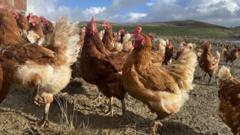Are Bird Flu Cases in Wales Prompting New Protection Zones?

Understanding Bird Flu: Protection Zones in Wales and What You Need to Know
In recent weeks, the emergence of bird flu cases in Wales has prompted significant public health measures. With confirmed cases in Pembrokeshire and Wrexham, the Welsh government has established protection and surveillance zones to contain the spread of avian influenza. This article will delve into the implications of these zones, the nature of bird flu itself, and steps that individuals and communities can take to stay informed and safe. By the end of this article, you will have a comprehensive understanding of the bird flu situation in Wales and how it affects both poultry and human health.
What is Bird Flu?
Bird flu, also known as avian influenza, is a viral infection that primarily affects birds but can occasionally infect humans and other animals. The virus is categorized into various subtypes based on two proteins found on the virus's surface: hemagglutinin (H) and neuraminidase (N). The most commonly reported strains in the UK include H5N1 and H7N9, both of which are of significant concern due to their potential to cause severe illness in both birds and humans.
Transmission of Bird Flu
Bird flu spreads through direct contact with infected birds, their droppings, and contaminated surfaces. While the risk of transmission to humans remains low, certain conditions can increase the likelihood of infection:
- Close Contact: Individuals working with birds, such as poultry farmers or veterinarians, are at greater risk.
- Contaminated Environments: Areas where infected birds have been present may harbor the virus.
- Consumption of Infected Products: Eating undercooked poultry or eggs can lead to infection.
Current Situation in Wales
As of recent reports, two specific areas in Wales have been marked by the Welsh government for heightened surveillance due to confirmed bird flu cases:
- Haverfordwest, Pembrokeshire: Confirmed case reported on a Monday.
- Glyn Ceiriog, Wrexham: Confirmed case reported on a Tuesday.
In response to these outbreaks, a 3km (1.9 miles) protection zone and a 10km (6.2 miles) surveillance zone have been established around each infected premises. These zones are designed to minimize the risk of further transmission and protect both avian and human populations.
Protection and Surveillance Zones Explained
Protection and surveillance zones come with specific regulations aimed at controlling the movement of poultry and reducing the risk of further outbreaks. Here’s what these zones entail:
- Protection Zone (3 km): Stricter measures are enforced, including the requirement for poultry keepers to record all movements of birds and their eggs.
- Surveillance Zone (10 km): While less strict than the protection zone, some movement restrictions may still apply to monitor the situation closely.
Within these zones, several mandatory measures have been put in place:
Mandatory Measures in Protection Zones
- Housing of Birds: All poultry and captive birds must be kept indoors or isolated from wild birds to prevent contact.
- Monitoring Movements: The occupiers of affected premises must log all movements of people and birds in and out of the zones.
- Disposal of Carcasses: Bird carcasses must be disposed of according to veterinary inspector instructions.
- No Spreading of Manure: The spreading of poultry litter and manure is prohibited unless performed by a licensed veterinary inspector.
Public Health Recommendations
The NHS has issued guidelines for the public to minimize the risk of bird flu transmission. Observing these recommendations can significantly enhance safety, especially for those in or near the affected zones:
General Safety Guidelines
- Avoid Contact: Steer clear of live birds when possible, particularly in areas where outbreaks have been reported.
- Hand Hygiene: Wash hands frequently with warm water and soap, especially before and after handling food or raw poultry.
- Use Separate Utensils: Employ different utensils for raw and cooked meats to prevent cross-contamination.
- Cook Thoroughly: Ensure that all poultry and egg products are cooked until steaming hot.
The Importance of Reporting Symptoms
Although rare, human infections with bird flu can occur, particularly among those handling birds. Symptoms of avian influenza include:
- Fever
- Cough
- Throat pain
- Muscle aches
- Shortness of breath
If you suspect that you may have been exposed to infected birds or are experiencing symptoms after contact, it is crucial to seek medical advice immediately. Early detection and treatment are vital for managing any potential health risks.
Understanding the Broader Impact of Bird Flu
Avian influenza not only poses a risk to human health but also has significant implications for the poultry industry and local economies. The outbreak can lead to:
- Economic Loss: Farmers may face losses due to the culling of infected birds and restrictions on poultry movement.
- Trade Restrictions: Affected areas may see export bans on poultry products, impacting local markets.
- Public Perception: Outbreaks can lead to decreased consumer confidence in poultry products, affecting sales.
The Role of Biosecurity in Prevention
To mitigate the risk of bird flu outbreaks, biosecurity measures are crucial. Poultry keepers must implement stringent practices to protect their flocks, including:
- Limit Access: Restrict access to poultry farms to essential personnel only.
- Clean and Disinfect: Regularly clean and disinfect equipment and footwear before entering bird areas.
- Monitor Health: Keep a close watch for signs of illness in birds and report any unusual symptoms immediately.
- Educate Staff: Ensure that all personnel are aware of biosecurity protocols and the importance of following them.
Conclusion
The confirmation of bird flu cases in Wales underlines the importance of vigilance and preparedness in the face of infectious diseases. By understanding the nature of bird flu, adhering to public health recommendations, and implementing biosecurity measures, we can collectively work towards minimizing the impact of this virus on both human and avian populations.
As the situation evolves, staying informed and proactive is vital for everyone, not just those in the affected areas. Together, we can help protect our communities and ensure the safety of our food supply. What measures do you think are essential to prevent the spread of avian influenza in your area? #BirdFlu #PublicHealth #Biosecurity
FAQs
What are the symptoms of bird flu in humans?
Symptoms may include fever, cough, sore throat, muscle aches, and shortness of breath. If you suspect exposure, seek medical advice promptly.
How can I protect my poultry from bird flu?
Implement biosecurity measures such as limiting access to farms, regular cleaning and disinfection, and monitoring bird health closely.
Is it safe to eat poultry during a bird flu outbreak?
Yes, as long as poultry and eggs are cooked thoroughly until steaming hot, they are safe to consume. Follow proper food handling practices to minimize risk.
Published: 2025-06-26 08:11:06 | Category: wales



